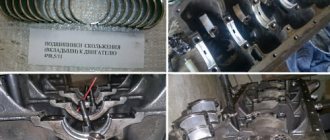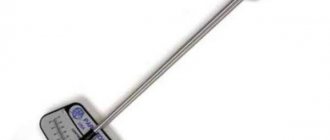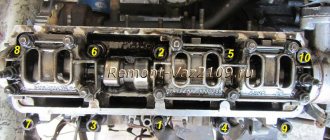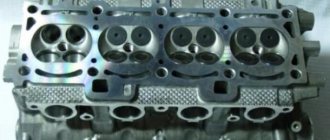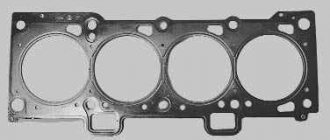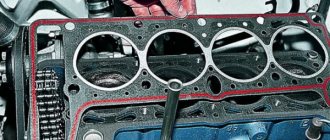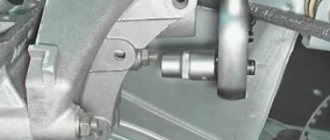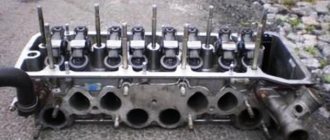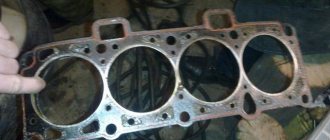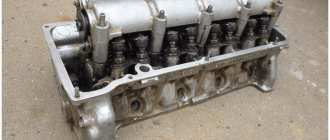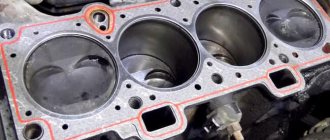The next tightening of the cylinder head must be carried out during each routine repair or maintenance of the power unit (change of oil or consumables). It is mandatory to carry out the procedure after intervention in the internal combustion engine structure, and additional tightening after 500-700 kilometers. It is not recommended and there is no need to climb into the mechanism anymore. After full tightening, the bolts sit firmly in their sockets and do not loosen due to vibration. Otherwise, leaks or burnout of the cylinder head gasket may occur, which can lead to major repairs.
Modern motors manufactured after 2010 do not require periodic tightening of the studs due to the updating of the device and mechanism.
Purpose and structure of the cylinder head
The cylinder head is a kind of combustion chamber cover. To enable the internal combustion engine to operate, intake and exhaust valves, spark plug(s) and various sensors are located here (depending on the design of the engine).
A complex part on modern cars is made of aluminum and contains a complex system of valve actuators, oil and cooling channels.
What happens in the cylinder head while the engine is running
Without delving into the “wilds” of engine building, there are two main forces acting on the cylinder head.
- Internal pressure of the combustion chamber. When the fuel ignites in the cylinder, an excess of forces is generated that turns the crankshaft. This force acts on all walls of the working chamber and the head as well.
- Intense heating causes the part to turn inside out. Increased temperature inside the combustion chamber can damage the cylinder head.
- Pressure inside lubrication and cooling lines. Inside the crankcase and cooling system there are pumps installed that supply fluid to the unit components.
Forces acting on the cylinder head during bolt tightening
The stable operation of the engine depends on the correct tightening of the bolts. When tightening the fastening elements, the part is subjected to strong pressure. In places where hairpins pass. Consequently, if you violate the sequence of actions, the head will be pulled and will have to be sharpened.
Working with a torque wrench
The dynamo key has a measuring scale that allows you to accurately determine the tightening force. Before use, a new key should be developed by making several tightenings at a minimum, due to which the parts of the mechanism will be lubricated. After use, the tool must be stored for storage, lubricated with a thin layer of machine oil. After each procedure, zero should be set (if a click key was used) so that subsequently the spring retains its elasticity and accuracy is maintained. With active use of the key, the spring still stretches, so it is recommended to calibrate it every year. When tightening, do not knock on the tool or use any extension cords.
If the motorist has a click-type key, then before tightening you need to select the required torque. To do this, unscrew the nut located at the bottom of the handle and set the desired value. After this, the nut is tightened. When tightening the cylinder head bolts, the key will click and begin to slip. This means that the required torque has been achieved.
Instructions for using a click key
The pointer tool does not allow you to set the tightening torque in advance, so the force will have to be controlled directly in the process. Tighten the fasteners carefully so as not to accidentally apply more force than necessary. It is better to indicate the required reading on the scale in advance. When twisted, the pointer remains stationary, and the handle with the scale moves.
An electronic dynamo key is similar to a click key, but the measurement is carried out using an electronic device. The moment is also set in advance. When it is reached, a beep sounds.
Mounting features
Regardless of the type of engine, the cylinder head is attached to the block using long studs. The fasteners are tightened in a certain sequence and with a large torque using a torque wrench. The use of the device is mandatory; the stability of the motor and the safety of the driver on the road depend on the accuracy of tightening.
Also, when installing the part, you should use a special gasket. The seal is made of materials that are resistant to pressure and elevated temperatures.
Torque wrench and its types
It is needed to tighten the cylinder head bolts. In 2022, devices are divided into three main types.
Snap key
A fairly popular type of device, widely used due to its moderate cost and ease of operation.
The principle of operation is based on setting the required torque on the main and auxiliary scales. When the set force is reached, the ratchet and key are activated and slip with a characteristic sound.
Arrow key
The very first and simplest variety, preserved from USSR times in many workshops. The operating principle is based on the resistance of the torsion bar when the torque increases.
The main disadvantage is the low accuracy of the device - over time, the torsion bar wears out and the key begins to lie in a larger direction.
Digital key
Digital devices are characterized by increased measurement accuracy, which allows them to be used on advanced internal combustion engines that require careful calibration.
Such keys are still rare in 2022 and are found mainly in workshops, due to their high cost.
Other devices
In the absence of a special tool, you can use improvised materials such as a long lever and a regular cantor. The point is to calculate the standard formula.
For example, to obtain a tightening torque of 10 Nm, you should use a 1 meter long lever and apply a force of 1 kg to its end.
Cylinder head bolt tightening torque
For the cylinder head of classic VAZ 2101-07 models, the nominal value is 8 kgf.m.
For other modifications, this moment is not suitable. As a sample, you can take the cylinder head of the Hyundai D4DD engine, where the recommended norm is 18 kgf.m. An important factor is the cleanliness of the operation. Before repairs, you need to clarify how many tightening bolts are designed for in a specific engine model. Some automakers make the elements disposable. This situation is justified by the risk of reuse - the bolts may simply not withstand the second application of load.
Next, before installation, it is imperative to remove all dirt, grease or dust residues from the threaded channels and the screws themselves. Otherwise, debris may clog the bottom of the well, which will prevent the part from being tightened completely.
Units of force applied
In European and CIS countries, it is customary to use Newtons multiplied by a meter. A universal unit of measurement is present on all instruments and torque wrenches. In Western Europe, the USA and Australia, Pounds*inch are used.
The “domestic” unit of measurement is more accurate, which confirms its spread.
Table of tightening torques for threaded connections
Among the most common cars, the following group stands out:
- KAMAZ;
- 8 valve Daewoo Nexia;
- Lada Granta;
- Hyundai Accent;
- Chevrolet Niva;
- Hino Ranger;
- UAZ Patriot;
- Toyota Rav-4.
These cars are considered the most popular guests of service stations, therefore, it is logical to make a list specifically based on the power units of the cars. The following is a table of torques for pulling cylinder head bolts of the most popular car models in Russia.
| Motor | Pulling torque N*m |
| GW 491 QE | 20,0 |
| UAZ 409 | 13-14,5 |
| 3SFE | 49 |
| 2AZFE | 7,8 |
| S2 Diesel | 24.0 |
| Daewoo Nexia 8th grade. | 25.0 |
| 405 | 40-50 + 90° turn |
| Granta all engines | 75,0+90° |
| WL-T | 9,0+180° |
| Kamaz 740 | 20,0+180° |
| J07C | 21,0+90° |
| 4A FE | 29,0/60,0 |
| D20DT | 85,0 |
| 5S FE | 49,0+90° |
| 1MZFE | 18,0+180° |
| YaMZ 536 | 10,0+180° |
| TagAZ | 10,0+90° |
| Chevrolet NIVA | 77,0 |
| X18XE | 25,0+270° |
| 1ZZFE | 40,0+90° |
| UMZ 4216 | 11,0+180° |
Tightening procedure for cylinder head bolts
The standard tightening pattern starts from the central screws to the edges. This rule must be strictly adhered to in order to avoid distortion or cracking of the aluminum “motor head”.
Typically the sequence of actions for a four-cylinder model looks like this:
From the first number you need to follow further to the edges. The effect of deformation of the head and gasket will be minimized. The procedure is similar for six or five cylinder in-line internal combustion engines. In the case of a V-shaped block, the sequence is relevant with the allowance for the fact that two heads are used there.
The following motors can be classified as standard row engines:
- ZMZ 406/402;
- GAZ 53;
- D 260;
- K24Z3;
- YaMZ 236;
- D 240.
Since these units are similar in design, the general system is applicable to them. This category includes the Lada Priora with 8/16 valves Chery Tiggo, and the VAZ 2108. Only Japanese engines of Mazda cars, some Toyotas, Hondas and Mitsubishi raise doubts. Due to the high-tech, complex design, the sequence of actions may vary.
Working with a torque wrench
Extreme caution should be exercised when using DMC. The tool is sensitive to mechanical damage - it’s easy to lose the calibration and the tool will become unusable.
Depending on the type of key, the principle and sequence of operation differs.
Which method of tightening fasteners is better?
Each method of tightening cylinder head threaded connections has its own pros and cons. Using a torque wrench allows you to achieve accurate results without damaging parts and bolts that can cause engine failure. The second method - without a dynamo key - is widely used among people due to its simplicity, accessibility and the absence of the need to purchase an expensive key. Despite the fact that professional mechanics advise using only the first method, car manufacturers in technical manuals often advise using a combined method. Its essence lies in the fact that when tightening torques exceed 8–10 kg*m, there is a high probability of a 100% error, even with the use of lubricants, so the fasteners are first tightened with a dynamo key to the specified values, and then turned at an angle. In practice, this method turns out to be the most effective, since the bolt is tightened until there is a characteristic click, which guarantees full compliance with the moment of force.
One of the important parts of the engine is the cylinder head. Correct tightening of bolts, torque determination and work order ensure uninterrupted operation of the cylinder head and power unit of the vehicle.
How to tighten cylinder head bolts without a torque wrench
The price of a professional instrument with acceptable accuracy reaches $200, which is beyond the means of the average person. However, physics gives users the right to independently manufacture a “likeness” of this instrument for a reasonable fee.
For this you will need:
- standard key;
- lever (pipe or other object);
- tape measure or ruler;
- standard scales (canter).
To tighten bolts without a torque wrench, you need to remember a little physics. The tightening torque is the applied force to the meter lever (kgf.m). Therefore, you need to measure the length of the key and divide 1 by the resulting number. Next, the result is multiplied by the tightening torque and the answer will be the required indicator on the scales.
For example, you can simulate the situation:
- nut with a required force of 3 kgf*m;
- open-end wrench 25 cm long;
- scales with an indicator of up to 20 kg.
Total:
- 1/0,25=4;
- 4*3 = 12.
Thus, if you attach a scale to the key, you need to pull the hook with a force of 12 kg. If it is necessary to tighten a bolt marked in Newtons, the force is calculated using the standard ratio here too.
Right moment
For older vehicles, two tightening torques are used. In newer models there may be significantly more of them. It is recommended to carry out the operation at an ambient temperature of about 20C.
The bolts are first cleaned of dirt. We recommend waiting 15–20 minutes after each tightening period to allow some tension to be released and deformation to go away. We provide a table with standard torque values, which must not be exceeded.
Features of the work performed using the example of some cars
In different cars, the procedure is performed according to the same scenario, but there are also nuances.
VAZ-2112 16 valves
On a 16 valve twelve, the head is secured with 10 bolts. Each element must be screwed in in a certain order in three steps.
- The first pass is performed at 20 N*m.
- Next, you need to tighten each screw 90 degrees.
- After 20-30 minutes, you need to perform step No. 2 again.
VAZ-2107
On the seven, the principle of operation is slightly different.
In the first pass, all bolts except No. 11 are tightened with a force of 3.5 kgf/m. The second approach implies a force of 11 kgf/m. Only on the third pull is screw No. 11 tightened with an indicator on the key of 4 kilos.
"Samara", 10th family, Priora
In Samara, twisting occurs from the center in 4 steps, where you need to do a pull-up of 2, then 8 kg and then two more pull-ups of 90 degrees.
"Volga"
The standard Volga ZML 402 engine has 10 cylinder head mounting nuts. They need to be tightened in the specified sequence in two approaches with a torque of 42 and 85 kgf/m.
After the first 2-3 starts and 5000 km, the fastenings should be tightened.
Basic recommendations
First of all, it should be noted that such a procedure can be carried out after repairing the power unit or in order to check the tightening torque of the bolts during engine operation. If the cylinder head has been dismantled, you should carefully inspect the bolts, as well as the holes in the cylinder block for their installation. Screws must not have elongation or deformation of the threaded part. The holes in the block for the bolts are cleaned of any remaining engine oil, liquid, or other foreign particles. If this is not done, the cylinder block may be damaged, and the cylinder head will not be able to be tightened with the required force.
This is interesting: Broken timing belt and possible consequences - causes, symptoms, repair
Work should begin only after reading the vehicle manufacturers' recommendations for operation and repair. There the driver will find all the necessary information to complete the job, including the forces and sequence of tightening the bolts.
Important! For engines with TTY bolts, there is a prohibition on reuse, as they may break.
Another feature of using such bolts is their installation at a certain angle. To do this, you will need a special key with an indicator that will show the degree of inclination.
User Igor Ivanov shows in the video the installation and tightening of the cylinder head.
.
Bolt tightening torque (force)
The tightening torque for the bolts is different for each car (due to design features). Each vehicle has its own table of fastener tightening torques. In the next section, we will consider the cylinder head fastening forces using the example of a VAZ head.
Table: tightening torques for connections depending on thread diameter
| Nominal thread diameter | Turnkey size of head, bolt (nut), mm | Thread pitch, mm | Strength classes according to GOST 1759–70 | ||||
| Bolt | |||||||
| 5.8 | 6.8 | 8.8 | 10.9 | 12.9 | |||
| screw | |||||||
| 6 | 10 | 1 | 0,5 | 0,8 | 1,0 | 1,25 | 1,6 |
| 8 | 12 — 14 | 1,25 | 1,6 | 1,8 | 2,5 | 3,6 | 4,0 |
| 10 | 14 — 17 | 1,25 | 3,2 | 3,6 | 5,6 | 7,0 | 9,0 |
| 12 | 17 — 19 | 1,25 | 5,6 | 6,2 | 10,0 | 12,5 | 16,0 |
| 14 | 19 — 22 | 1.5 | 8,0 | 10,0 | 16,0 | 20,0 | 25,0 |
| 16 | 22 — 24 | 1,5 | 11,0 | 14,0 | 22,0 | 32,0 | 36,0 |
| 18 | 24 — 27 | 1,5 | 16,0 | 20,0 | 32,0 | 44,0 | 50,0 |
| 20 | 27 — 30 | 1,5 | 22,0 | 28,0 | 50,0 | 62,0 | 70,0 |
| 22 | 30 — 32 | 1,5 | 28,0 | 36,0 | 62,0 | 80,0 | 90,0 |
| 24 | 32 — 36 | 1,5 | 36,0 | 44,0 | 80,0 | 100,0 | — |
Correct tightening order
There is a certain order for tightening the bolts; it is the same on almost all cars - from the center of the head to its edges, cross to cross. So, for example, the two central bolts of the right and left rows are tightened first, then the two bolts located to the left of the central ones, then the two to the right of the central ones, then the two bolts located on the left in both rows, and the bolts located on the right in both rows complete the order.
It is important to remember that fastening is always performed in three to four approaches:
- The first approach is a force of 3-4 kgf.
- The second approach is a force of 7 kgf.
- The third approach is a force of 9 kgf.
- The last approach is a force of 11.5 - 12 kgf.
Some nuances
The tightening torque is one of the main factors for the normal fit of the block head. But this criterion is influenced not only by the applied force, but also by the fasteners themselves:
- General condition of the bolts – new or used;
- Presence of lubricant on the threaded part;
- Thread condition.
The type of power plant (petrol, diesel), as well as the number of valves, does not affect the cylinder head tightening technology. But this does not mean that the force and tightening procedure are identical for all motors, and before seating the head, you should definitely study the conditions for performing the operation and all its features.
Errors when installing the head
If you do not use a torque wrench when installing the cylinder head, you may make a mistake with the force, which will lead to uneven torque. In such cases, there will be excessive or insufficient force, which will result in either deformation of the head surface or allow the breakthrough of gases, oil or coolant. In both cases, this is fraught with serious consequences for the engine.
If you follow the rules for tightening the fastening bolts, as well as the required torque, you can always count on reliable and durable operation of the installed parts. The gas distribution mechanism in the engine plays a major role, so you should not neglect the rules for installing the component elements.
